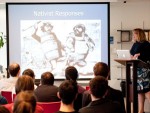Title
Xenophobia, as anyone who watches the news could attest, occupies a prominent position in contemporary American politics. What many do not realize, suggests Stacey Horstmann Gatti, a professor of history at Long Island University and recent lecturer in Juilliard’s Liberal Arts Speaker Series, is that it occupies an equally significant place in American history.
Body
In a talk on March 25 titled “The Dynamics of American Immigration: The Reality and Myths of the ‘Great Melting Pot,’” Gatti presented what she termed the “optimistic” and “pessimistic” myths concerning immigration. The pessimistic myth, Gatti explained, generally runs along the lines of this complaint:
“Few of their children in the country learn English. … The signs in our streets have inscriptions in both languages. … They will soon so outnumber us, that all the advantages we have will not in my opinion be able to preserve our language, and even our government will become precarious.”
Reading this quote, Gatti pointed out the striking similarity it bears to remarks someone like radio and former television host Lou Dobbs—known for his conservative views on immigration—might make. Benjamin Franklin, its actual source, was speaking about German immigrants in Pennsylvania. In over two and a half centuries, this myth has barely changed: new immigrants are somehow “different” from those of previous generations; they will never assimilate and their presence will subvert American culture.
In the lecture, Gatti said that many conservative movements have been motivated by “a fear that the country is going in the wrong direction because, in part, of changing demographic trends.”
Gatti introduced the optimistic myth with a Schoolhouse Rock video titled The Great American Melting Pot, which includes such inspiring lyrics as, “You simply melt right in/ it doesn’t matter what your skin/ it doesn’t matter where you’re from/ or your religion—you jump right in to/ the great American melting pot.” This fairy tale version of reality, Gatti pointed out, is at least as misguided as the pessimistic myth, if less menacingly so.
These myths, Gatti argued, fail to take into account the primary motivations of immigration: economic necessity and cultural constraints. That is, immigrants come to the United States either because they cannot make ends meet in their country of origin, as the influx of Irish during the potato famine of the mid-19th century attests, or because of oppression at home, as more recently with Hmong immigrants after the Vietnam War. Immigrants do not come to the United States hoping to immediately shed their cultural identities, but they don’t arrive with an agenda of subversion and domination, either. However, history demonstrates that the dominant American attitudes toward immigrants are grounded in the unrealistic expectation of immediate assimilation and an irrational fear of the other.
In reality, immigrant groups do at least partially assimilate, but the umbrella of perceived American-ness also expands to encompass newer groups and their customs as they enter American culture and become less novel and scary. Also, more well-established groups benefit indirectly from xenophobia directed at newer arrivals; concerns over German and Irish immigrants subsided as immigrants from Italy and other Southern European countries began arriving en masse.
Gatti noted that, historically, changing perceptions of race have accompanied changing attitudes toward American immigrant groups. Benjamin Franklin wrote about German immigrants’ “swarthiness” as a negative trait; they, along with the Irish, were long considered non-white in the Eastern United States, a circumstance altered by the arrival of Southern and Eastern European immigrants, who then became a new racial out-group. However, in late 19th-century California, Gatti said, “the concerns of workers, rather than of the elite,” determined racial boundaries; all European-Americans became white in the face of the perceived threat of Chinese competition in the workforce.
The racial tensions of the late-19th century, Gatti stressed, still exert a profound influence on American immigration policy. The response to these tensions, the Chinese Exclusion Act, signed into law in 1882, temporarily suspended all immigration from China to the United States, and, even more significantly, set a precedent for immigration policies that discriminate by country of origin. Building on the prototype of the Chinese Exclusion Act, in 1924 Congress passed a sweeping reform of immigration policy that severely restricted immigration from almost all countries outside of Northern Europe. This reform underlies the current state of American immigration law, as well as, Gatti suggested, the “unprecedented” predicament we find ourselves in with millions of immigrants living unofficially inside the United States, unprotected by American law.
The xenophobia underlying many objections to immigration notwithstanding, Gatti emphasized that concerns over immigration are not out of place in a democratic society. “There is some ground for anxiety,” Gatti said, if it appears immigrants do not recognize that “we are all in this together.” Democracies require “good, upstanding citizens” to function. However, Gatti added, not everyone agrees what constitutes an upstanding citizen. The founding fathers thought such a person had to be a white male landowner; American discourse on citizenship has progressed in the last 200 years.
Asked about her interest in immigration, Gatti, noting her upbringing in the heterogeneous New York area, responded, “In a general sense, I have always been interested in the history of immigration for as long as I can remember.” She also highlighted the educational value of teaching to both teachers and students. Until an eye-opening experience teaching a survey course in American history at Emory University, she said, “I simply accepted the melting pot trope.” The rest, as they say, is history.





